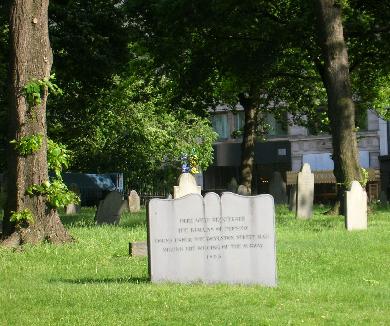20. Central Burying Ground, Boston. Corner of
Tremont and Boylston Streets.
|
|
 |
| This picture shows the marker for the graves that were moved during the building of the subway. |
|
|
According
to Samuel Adams Drake, the British buried the dead from the Battle of Bunker
Hill and any soldier who died of disease during the subsequent winter
occupation, in a trench at the southwest corner of the common. Lieutenant Hall (or Hull) died in Arlington and his body
was returned to the General Gage. He was
probably buried here. Lieutenant Knight
died in Boston of wounds,
and was also probably buried here.
The
23 soldiers who died of wounds in Boston in the
following days probably were also buried here.
In
1836, the Boylston Street Mall was created and any obstructing graves unclaimed
by ancestors were buried under the new walkway.
During the construction of the subway under Tremont and Boylston Streets
in 1894, the remains of about 910 people were unearthed. The remains were re-interred in 1895 and a
slate tablet with three boundary stones was placed to mark the spot. Thus, it is likely that the British soldiers
are in this mass grave.
|
|